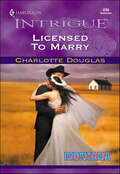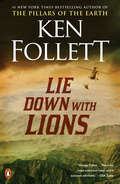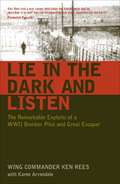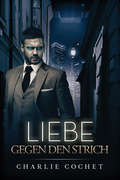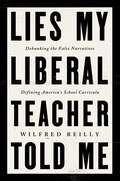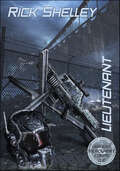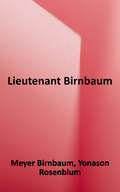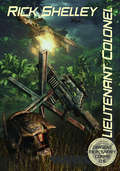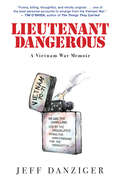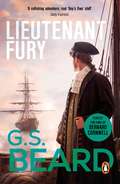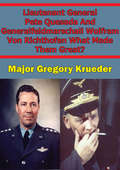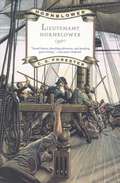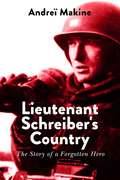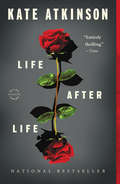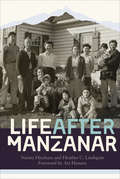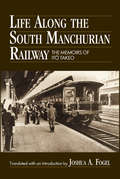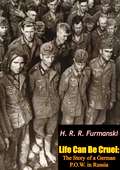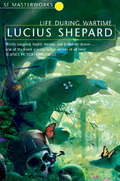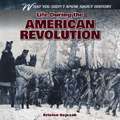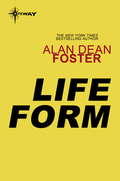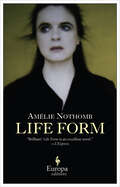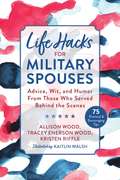- Table View
- List View
Licensed to Marry (Montana Confidential)
by Charlotte DouglasBy day these agents are cowboys; by night they are specialized government operatives. Men bound by love, loyalty and the law-they've vowed to keep their missions and identities confidential...THE MISSION: UNDERCOVER HUSBANDNo woman had ever looked more beautiful to Kyle Foster than the trembling female he rescued from the wreckage of an explosion. But he never dreamed he'd marry Laura Quinlan just days later! When traces of the bomb led to a security leak inside Laura's top-secret laboratory, a stricken Laura made Kyle a shocking proposal-marry her, and infiltrate the lab to find the traitor. As a Confidential agent and single father, Kyle would do anything to make the world a safer place. But living with Laura could prove a deadly distraction. Kyle's daughter loved her. Kyle's own heart was in jeopardy. And now the enemy knew it...
Lie Catcher: Become a Human Lie Detector in Under 60 Minutes
by Dr. David CraigInternational undercover expert and criminologist Dr David Craig gives us an easy-to-read, light-hearted guide that demonstrates through practical examples how to apply lie detecting skills in our day-to-day lives. From bargaining, making a purchase, negotiating a business contract, dealing with children to identifying infidelity, he delivers simple but effective tips and techniques we can all use to see behind the facade and get to the truth.
Lie Down with Lions
by Ken FollettEllis, the American. Jean-Pierre, the Frenchman. They were two men on opposite sides of the cold war, with a woman torn between them. Together, they formed a triangle of passion and deception, racing from terrorist bombs in Paris to the violence and intrigue of Afghanistan--to the moment of truth and deadly decision for all of them...
Lie in the Dark and Listen: The Remarkable Expliots of a WWII Bomber Pilot and Great Escaper
by Ken Rees Karen ArrandaleA memoir of a World War II British bomber pilot who was imprisoned by the Nazis and went on to inspire the Steve McQueen character in The Great Escape. By age 21, Ken had already trained to be a pilot officer, flown 56 hair-raising bomber missions by night over Germany, taken part in the siege of Malta, got married, been shot down into a remote Norwegian lake, been captured and interrogated, sent to Stalag Luft III, and survived the Great Escape and the forced March to Bremen. This is truly a real-life adventure story, written with accuracy, pace, and drama. &“Ken Rees had a war career that takes the breath away and he describes it so well one can imagine one was there, experiencing the terror.&” —Frederick Forsyth, #1 New York Times – bestselling author of The Fox and The Day of the Jackal &“In an age obsessed with C-list television celebrities battling it out on [phony] &“reality&” survival shows, Rees and his dwindling band of Great Escapers stand out as the real thing.&” —The Daily Telegraph (UK) &“Written in frank, warm and readable style, this is a very engaging account of a remarkable life.&” —New History &“A brave man&’s memory. Hear the fear yet take [succor] from the courage.&” —North Wales Chronicle (UK)
Liebe gegen den Strich
by Charlie Cochet A. D. FerenczKelly Sutton ist ein ehrgeiziger junger Amerikaner, der als Praktikant bei der Photonic Royal Society in New London arbeitet. Seit über einem Jahr ist er dem Projekt Mars zugeteilt, das so geheim ist, dass selbst Kelly nicht weiß, worum es sich dabei genau handelt. Er weiß nur, dass seine Mitarbeit an dem Projekt zum Wohl der Menschheit ist. Und mehr interessiert ihn auch nicht. Kellys Welt wird auf den Kopf gestellt, als ihn die Sorge um das merkwürdige Verhalten seines Mentors zufällig über ein streng gehütetes, fürchterliches Geheimnis stolpern lässt. Hinter dem Projekt, das offiziell der Verbesserung des menschlichen Lebens dienen soll, verbirgt sich das Potential zu Gewalt und Vernichtung. Diese schreckliche Erkenntnis zwingt Kelly zu einer Entscheidung. Soll er die Augen vor der Wahrheit verschließen und seinen Job behalten, wie er es immer getan hat, oder soll er seine Karriere riskieren und den Mann retten, der ihm das Herz geraubt hat?
Lies My Liberal Teacher Told Me: Debunking the False Narratives Defining America's School Curricula
by Wilfred ReillyA college professor debunks the myths that have infiltrated America's school curricula.In 1995, James W. Loewen penned the classic work of criticism Lies My Teacher Told Me, a left-leaning corrective that addressed much of what was sanitized and omitted from American history books.But in the decades that followed, false leftist narratives—as wrong as those they supplanted—have come to dominate American academia and education. Now, in the same spirit but updated for 2024, Wilfred Reilly demolishes the scholastic myths propagated by the left, uncovers fresh angles on “established” events, and turns what we think we know about history upside down. Among the popular lies he debunks:“The ‘Red Scare’ was a moral panic that caught no commies”“Native Americans were peaceful people who spent all day dancing”“European colonialism was—empirically—a no-good, terrible, very bad thing” “The racist ‘Southern Strategy’ turned the South Republican”“The Vietnam War was unpopular and pointless”Lies My Liberal Teacher Told Me sets the record straight on many of these myths, explaining that there actually were communists in Hollywood; that many Native American tribes were cannibals, owned slaves and made them march the Trail of Tears with them; and that history, while almost always bad for Black Americans, was much worse for all of us than we tend to think it was. Smart, irreverent, and deeply researched, Lies My Liberal Teacher Told Me will revolutionize your understanding of history and reveal a new and refreshing way to teach and think about the past.
Lieutenant (Dirigent Mercenary Corps Ser. #2)
by Rick ShelleyIn this second entry in the classic military science fiction action series, a military academy reject rises learns to lead in the face of danger.The year is 2804 AD. Humanity has colonized the universe. But the authority of the Confederation of Human Worlds is spread thin. Where the Army of planet Earth cannot reach, mercenaries must keep the peace—and the Dirigent Mercenary Corps are the best of the best.Kicked out of the prestigious North American Military Academy, Lon Nolan had only a few choices left to him. He chose the hardest one: serving with the Dirigent Mercenary Corps, an elite fighting squad where respect is earned not in the classroom but on the battlefield.Nolan proved himself on the battlefield on Norbank. But now he’s commanding men of his own, and the stakes are higher. He’s going to learn sooner or later that leadership always comes with a cost . . . The Dirigent Mercenary Corps books are classics of military science fiction. Rick Shelley was himself a veteran of the U.S. Army, and his experience and knowledge shine through on every page.
Lieutenant Birnbaum: A Soldier's Story
by Meyer BirnbaumJoin Meyer Birnbaum as he enlists in the U.S. Army, helps liberate Buchenwald, trains youngsters for Israel's War of Independence, and drives the Mirrer Rosh Yeshivah and countless others daily to the sunrise minyan at the Kosel.
Lieutenant Colonel (Dirigent Mercenary Corps #5)
by Rick ShelleyMercenary Lon Nolan returns in a mind-blowing, far-future military science fiction thriller from the national bestselling author of Major. The year is 2804 AD. Humanity has colonized the universe. But the authority of the Confederation of Human Worlds is spread thin. Where the army of planet Earth cannot reach, mercenaries must keep the peace—and the Dirigent Mercenary Corps are the best of the best.Lon Nolan has distinguished himself at the DMC, and he has the battle scars to prove it. Now, the governor of the isolated mining planet of Bancroft again needs Lon’s help. The Colonial Mining Cartel is terrorizing the planet, and Lon is the only person who can stop it. He’d never thought he’d have to return, and now he’s going back to face a more disciplined adversary than ever before. This time, the responsibility for the Second Battalion falls on him.“Rick Shelley was a soldier at heart, and his books were written from the heart. They carry the real feel of the sweat, blood, and camaraderie of those on the front lines.” —Jack Campbell, New York Times–bestselling author“Rick Shelly knows how to write compelling military science fiction thrillers that are so action packed, readers hardly have a moment for an oxygen break.” —AllReaders.com
Lieutenant Dangerous: A Vietnam War Memoir
by Jeff Danziger"A must-read war memoir… with zero punches pulled, related by one of the most incisive observers of the American political scene." —KIRKUS (starred review) "Funny, biting, thoughtful and wholly original." —Tim O'Brien, author of The Things They CarriedJeff Danziger, one of the leading political cartoonists of his generation, captures the fear, sorrow, absurdity, and unintended but inevitable consequences of war with dark humor and penetrating moral clarity.If there is any discipline at the start of wars it dissipates as the soldiers themselves become aware of the pointlessness of what they are being told to do. A conversation with a group of today&’s military age men and women about America&’s involvement in Vietnam inspired Jeff Danziger to write about his own wartime experiences: &“War is interesting,&” he reveals, &“if you can avoid getting killed, and don&’t mind loud noises.&” Fans of his cartooning will recognize his mordant humor applied to his own wartime training and combat experiences: &“I learned, and I think most veterans learn, that making people or nations do something by bombing or sending in armed troops usually fails.&” Near the end of his telling, Danziger invites his audience—in particular the young friends who inspired him to write this informative and rollicking memoir—to ponder: &“What would you do? . . . Could you summon the bravery—or the internal resistance—to simply refuse to be part of the whole idiotic theater of the war? . . . Or would you be like me?&”
Lieutenant Fury: a brilliantly engaging and rip-roaring naval adventure set during the French Revolutionary Wars that will keep you hooked!
by G.S. BeardIf you like Hornblower and Sharpe, you will love this all-action nautical page-turner from much loved author G.S.Beard. You'll feel as if you are in the midst of the action!'If you like sea stories, you will enjoy this, and even if you think you don't but enjoy things like Sharpe, it might just convert you' - HISTORICAL NOVELS REVIEW'Kept me spellbound' -- ***** Reader review'A fun, fast read' -- ***** Reader review'Excellent story and very exciting' -- ***** Reader review*************************************************************1793: the French Revolutionary Wars continue...When HMS Amazon is returning from an arduous duty in the Indian Ocean, she encounters a French frigate in the Atlantic which unexpectedly opens fire - a bloody sea battle ensues resulting in both triumph and personal tragedy for Acting Lieutenant John Fury.A battered Amazon puts into Gibraltar for repairs and newly promoted Fury finds he is to be transferred away from his home on the Amazon and set a new challenge: he will be the fifth lieutenant on the 74-gun-man of war Fortitude.The action never stops in Toulon, where Fury is posted and he eventually finds himself defending a prominent fort ashore as the Republican armies, inspired by a young artillery officer by the name of Napoleon Bonaparte, establish a brutal siege of the port. It is soon clear that Britain and her allies are going to be hard pressed to hold onto their prize.But Fury has more to lose than most - in the maelstrom of the siege he has met and fallen in love with a pretty French girl, Sophie Gourrier.Somehow, as the defence crumbles, he must rescue his men and Sophie from the doomed city.John Fury's adventures started in Mr Midshipman Fury - have you read it?
Lieutenant General Pete Quesada And Generalfeldmarschall Wolfram Von Richthofen What Made Them Great?
by Major Jeremy KreuderDuring World War II, certain air force generals demonstrated an uncommon ability to succeed on the battlefield in spite of considerable obstacles. Whether solving operational issues, developing technical innovations, or devising logistic solutions, these commanders transcended service-centric doctrine and loyalties in order to achieve their objectives. Are there common elements among their personal background, professional education, officer development, and operational experience that helps explain their success? This paper will examine two contemporary tactical airpower commanders, Lieutenant General Elwood "Pete" Quesada and Generalfeldmarschall Wolfram Freiherr Von Richthofen, in an attempt to answer this important question.This study comprises an analysis of two contemporary tactical airpower commanders from World War II, Lieutenant General Elwood "Pete" Quesada and Generalfeldmarschall Wolfram Freiherr Von Richthofen. It attempts to determine how they succeeded where others failed. Whether solving operational issues, developing technical innovations, or devising logistic solutions, these commanders transcended service-centric doctrine and loyalties in order to achieve their objectives. The author searches for common elements among their personal background, professional education, officer development, and operational experience that help explain their uncommon triumphs. The analysis includes both external and internal factors to determine which is dominant. The final section includes five recommendations intended for those who conduct officer accession, professional development, and promotion boards. The ultimate objective is to provide timeless criteria that transcend technological advancements and the changing character of war.
Lieutenant Hornblower (The Hornblower Saga, Book #7)
by C. S. ForesterWith interest in nautical adventure stories reaching unprecedented heights -- as evidenced by the success of "The Perfect Storm", Patrick O'Brian's bestselling Aubrey/Maturin novels, the Titanic phenomenon, etc. -- now is the ideal time for readers to rediscover the pleasures and excitement of C. S. Forester's epic saga of turmoil and triumph on the high seas. "The Horatio Hornblower" novels, which recount the thrilling adventures of one of the most daring and resourceful officers in the Royal Navy as he wrestles with his own "accursed unhappy temperament" and as he sails valiantly into battle after battle against Napoleon's forces, have riveted and delighted millions of readers since the series was initiated in 1938.
Lieutenant Schreiber's Country: The Story of a Forgotten Hero
by Andrei MakineJean-Claude Servan-Schreiber enlisted in the French army at the outset of World War II and quickly rose to the rank of lieutenant. Despite his patriotism and courage in defending his country, in which he narrowly escaped death several times, he suffered the bigotry of his fellow soldiers until he was expelled from the army for being Jewish. He sought exile in Spain and was deported and interned in a concentration camp before he managed to join the Allied army in North Africa. He eventually participated in the triumphant liberation of his homeland.His story, almost forgotten, would have remained unknown if not for the efforts of the award-winning and internationally bestselling author Andrei Makine, Retelling Servan-Schreiber's dramatic life with a novelist's skill, he reveals a man who embraced experience in all its joys and sorrows, who knew the pleasures of love amid the savagery of war, and who could forgive the hatred he was subjected to but never forget it. In Servan-Schreiber, who is now nearly a centenarian, Makine celebrates virtues that every citizen should be reminded of: self-sacrifice, honor, love of country, and true heroism.
Life After Life: A Novel
by Kate AtkinsonWhat if you could live again and again, until you got it right? On a cold and snowy night in 1910, Ursula Todd is born to an English banker and his wife. She dies before she can draw her first breath. On that same cold and snowy night, Ursula Todd is born, lets out a lusty wail, and embarks upon a life that will be, to say the least, unusual. For as she grows, she also dies, repeatedly, in a variety of ways, while the young century marches on towards its second cataclysmic world war. Does Ursula's apparently infinite number of lives give her the power to save the world from its inevitable destiny? And if she can -- will she?Darkly comic, startlingly poignant, and utterly original -- this is Kate Atkinson at her absolute best.
Life After Manzanar
by Naomi Hirahara Heather LindquistFrom the editor of the award-winning Children of Manzanar, Heather C. Lindquist, and Edgar Award winner Naomi Hirahara comes a nuanced account of the “Resettlement”: the relatively unexamined period when ordinary people of Japanese ancestry, having been unjustly imprisoned during World War II, were finally released from custody. Given twenty-five dollars and a one-way bus ticket to make a new life, some ventured east to Denver and Chicago to start over, while others returned to Southern California only to face discrimination and an alarming scarcity of housing and jobs. Hirahara and Lindquist weave new and archival oral histories into an engaging narrative that illuminates the lives of former internees in the postwar era, both in struggle and unlikely triumph. Readers will appreciate the painstaking efforts that rebuilding required, and will feel inspired by the activism that led to redress and restitution—and that built a community that even now speaks out against other racist agendas. Published in collaboration with Manzanar History Association
Life Along the South Manchurian Railroad
by Joshua A. Fogel Ito TakeoAs part of a worldwide movement, nations and multinational groups are trying to reach closure regarding past atrocites and inhumanites, including what happened in Nanking in 1937. The contributors to this book show that these activites are a search for the common causes of human atrocites.
Life Can Be Cruel: The Story of a German P.O.W. in Russia
by H. R. R. FurmanskiOriginally published in 1960, this compact book tells the true story of a German soldier: from his early childhood during the First World War, through to his harrowing experiences on the frontline during the Word War II, culminating in his capture by the Red Army on 20 December 1942…An astonishing first-hand account.
Life During Wartime
by Lucius ShepardIn Guatemala, David is slugging it out the rotting vegetation and his despairing foot soldiers. Beyond the warzone, he meets Debora, who may be working for the enemy, and stumbles into a deadly psychic conflict where the mind is the greatest weapon.
Life During Wartime (S.F. MASTERWORKS)
by Lucius ShepardIn the jungles of Guatemala, David Mingolla is struggling to survive amongst the rotting vegetation and his despairing fellow foot soldiers. He knows he is nothing but an expendable pawn in an endless war. On R & R a few miles away from the warzone he meets Debora - an enigmatic young woman who may be working for the enemy - and stumbles into a deadly psychic conflict where the mind is the greatest weapon.
Life During the American Revolution (What You Didn't Know About History)
by Kristen RajczakThe American Revolution was full of odd events not usually included in history books. Some of these events include: the tar and feathering of British supporters and battles taking place in farmers fields. Readers will find many new and sometimes funny facts in this book, such as patriot soldiers leaving the war to harvest their crops. Surprising fact boxes and distinctive historical information engage readers with a unique look at the Revolutionary War.
Life Form
by Alan Dean FosterWhen a team of scientists starts to investigate the flora and fauna of the distant planet of Xica, it soon becomes apparent that this is a unique opportunity to study alien life forms. The planet offers a rich and varied eco-system and each of the scientists recognises what this could mean for their individual reputations.And then, their dreams come true - they establish first contact with a humanoid civilization.But this is a planet where nature breaks all the rules, where logic falls apart, and where nothing is as it seems. And their dreams turn into a nightmare.
Life Form
by Amélie NothombA fictional correspondence with a desperate American soldier leads to a strange new reality in this surreal novel of trauma, healing, and war.One morning, the heroine of this book—a famous Belgian author named Amélie Nothomb—receives an unusual fan letter. Melvin Mapple, an American soldier stationed in Iraq, tells her of the horrors around him. And of his only comfort, eating. He eats and eats until his ever-growing bulk starts to suffocate him. Disgusted with himself, but unable to stop, he labels his excess self Scheherazade as a way to cope.Repulsed yet fascinated by Mapple’s story, Nothomb begins exchanging letters with him. She opens up about her artistic process and the challenges of being in the spotlight. Their far-reaching conversation delves into universal questions about humanity and relationships. But their epistolary friendship takes a surprising turn when the novelist discovers bizarre facts lurking behind Mapple’s complex personal story.
Life Hacks for Military Spouses: Advice, Wit, and Humor from Those Who Served Behind the Scenes
by Tracey Enerson Wood Allison Wood Kristen RiffleA colorful collection of tips and tricks for getting the most out of the nomadic military lifestyle. Told through humorous anecdotes by those with years of unique experiences, these life hacks reveal a special culture with expectations and numerous obstacles to be faced along the way. Military life boasts of travel to exotic places, immersion in the worldly cultures, and cuisine that most Americans can only dream about . . . and on the government&’s dime, to boot! At least, that&’s what the common perception is. But those who have served know that while the above may be true, military life comes with its own set of challenges and can be a hardship as much as it is rewarding. Here to help is the advice, guidance, and personal stories of spouses from all walks of life, in stages from the newlywed to the retired and properly salty. They share tips on overcoming the numerous obstacles, and navigating the special culture, traditions, and the one-of-a-kind lingo of military service. Gathered mostly from those who are affiliated with the military, but also from those with similar diplomatic lifestyles, the anecdotes reveal the special bond they share with their fellow spouses, and the wisdom gained to pass to the next generation.The very special illustrations were created by a talented Air Force wife, and reflect both the strong beauty and earnestness of those who are engaged in our nation&’s most serious business, and yet, have learned not take themselves too seriously.
